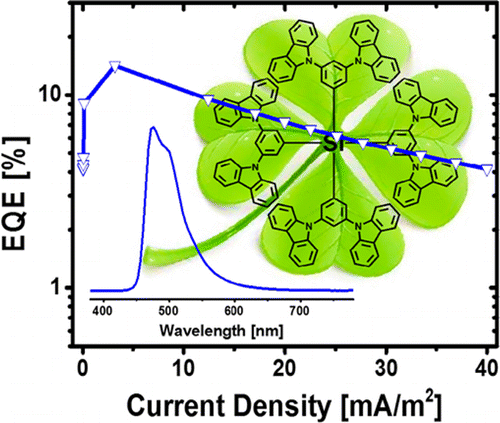
Multi-3,3′-Bicarbazole-Substituted Arylsilane Host Materials with Balanced Charge Transport for Highly Efficient Solution-Processed Blue Phosphorescent Organic Light-Emitting Diodes
Dianming Sun, Xiaokang Zhou, Huihui Li, Xiaoli Sun, Zhongjie Ren, Dongge Ma and Shouke Yan
Abstract : A series of 3,3′-bicarbazole (mCP)-functionalized tetraphenylsilane derivatives (SimCPx), including bis(3,5-di(9H-carbazol-9-yl)phenyl)diphenylsilane (SimCP2), tris(3,5-di(9H-carbazol-9-yl)phenyl)methylsilane (SimCP3-CH3), tris(3,5-di(9H-carbazol-9-yl)phenyl)phenylsilane (SimCP3-Ph), and tetrakis(3,5-di(9H-carbazol-9-yl)phenyl)silane (SimCP4), serving as bipolar blue hosts for bis[2-(4,6-difluorophenyl)pyridyl-N,C2′]iridium(III) (FIrpic), have been synthesized by incorporating different ratios of mCP subunits into a central silicon atom. All of the SimCPx derivatives have wide bandgaps and high triplet energies because of the indirect linkage by silicon between each mCP subunit. The good solubility and high thermal and morphological stability of SimCPx are beneficial for forming amorphous and homogeneous films through solution processing. Density functional theory simulations manifest the better bipolar characteristics for SimCPx using three and four mCP units rather than the represented bipolar host SimCP2. As a result, SimCP4 presents the best electron-transporting ability for charge balance. Consequently, the lowest driving voltage of 4.8 eV, and the favorable maximum efficiencies of 14.2% for external quantum efficiency (28.4 cd A–1, 13.5 lm W–1), are achieved by solution-processed, SimCP4-based blue phosphorescent organic light-emitting diodes as the highest performance among SimCPx, in which 32% improved device efficiencies compared to that of SimCP2 are obtained. It is inspiring to develop efficient bipolar hosts for blue phosphors by just incorporating monopolar carbazole into arylsilanes in two steps.
